

Carnatic music had moved on from closed-door parlour concerts hosted by royalty to the wider appreciation of the Presidency only in the 1900s, mainly through the advent of sabhas.
But it became a closed-door affair once again, with only a modest group of aficionados frequenting it. The reason was that film songs had become the dominant form of music for the masses.
Playback singers and actors, including the great MK Thyagaraja Bhagavathar (MKT) himself, have performed kutcheris, perhaps to show they were in touch with their roots. But a combined success in both fields eluded most of them, except one.
In the early 1950s, when rasikas enjoyed the Carnatic renditions of Madras Lalithangi Vasanthakumari (MLV) in the sabhas, rickshaw pullers who ferried the patrons were humming her filmy songs in the parking lot outside. Never before, and never again, would a musician command such sway in both the cinematic and Carnatic arenas.
In her teens, MLV became a disciple of singer GN Balasubramanian (GNB) upon his request. GNB, who was backed by a college education, saw Carnatic music through a different lens. He was bold enough to experiment and added dollops of creativity to unleash on an unsuspecting audience his baani — a distinct style.
GNB saw in MLV the perfect vehicle for the continuity of his style (though she aspired to become a doctor). That she, a convent educated girl, would imbibe his musical genius, and add her own innovation as well to evolve her own style and win hearts wasn’t something even GNB would have foreseen.
MLV’s stage persona was stunning to say the least. With a big red vermillion pottu on her forehead, a ring of freshly plucked jasmine on her tresses, her carefully chosen attire, her lips red with chewed betel and applied lipstick supplemented the confidence she exuded.
She was an expert planner, and the tempo of her entire three-hour concert would not sag for a second. To MLV, every song was an adventure. Her graceful namaskaram to the audience was the only thing predictable about her performance. When she got down to the brass tacks, she’d transport her rasikas to a uniquely melodious realm.
At the time, women in Carnatic music were not at the forefront to start with. But in no time people flocked to MLV’s kutcheris. She was acknowledged as one among the female triumvirate along with MS Subbulakshmi and DK Pattammal.
When the aficionados of classical music in the Madras Presidency argued about whether Tamil or Telugu songs needed to occupy centrestage, other musicians took sides. MS went with the Tamil Isai Sangam, while Pattammal remained with the Music Academy.
MLV emerged as an unbiased performer, mainly because she had a huge repertoire of Tamil and Telugu songs. Purandara Dasa songs in Kannada got a great fillip when MLV made it mandatory to add such creations in her recitals. Her renderings of Thirupaavai evolved into a household prayer during the Margazhi month.
MLV baani is active even today and has been kept alive by an extensive lineage of her students. Even her teaching methodology was unique. With a disdain for one-to-one tutorials, she preferred students wandering alongside her during her busy schedule. The disciples in turn would pick up nuggets of musical wisdom, which they used as a stepping-stone to a great stage career.
While there were reports of MLV harbouring hopes that her daughter Srividya would follow in her footsteps, Srividya would break away from tradition and create a path of her own, while emerging as a brilliant actress.
But a stellar stage singer becoming the queen of playback singing in Tamil cinema was the greatest turn in her career. MLV’s foray into films brought her more public adulation. Her first stage appearance was in Krishna Bhakti which had her perform a traditional kutcheri onscreen.
But that was the closest she came to becoming a heroine. Though there were rumours that MKT wanted to be paired with her in Raja Mukthi, his ‘comeback after jail’ film, she chose to remain a playback singer. She had accompanied his film crew to Pune where the troupe got trapped in a studio for weeks, as violence erupted in the aftermath of Mahatma Gandhi’s assassination.
That MLV’s voice was heard all over with the most popular voice in Tamil Nadu (MKT) helped build familiarity. MLV sang background songs till 1967 singingeven with Yesudas.
When it came to her film songs, music directors permitted MLV to render tracks in her own way causing many embarrassing moments for the co-artists. Ace singer Chidambaram Jayaraman once missed singing a stanza, while recording a song for a Sivaji film, awestruck by his co-singer’s rendition. When grilled by the music director on the lapse, he retorted, “Who can sing with that rakshasi (demoness) in there?”
Ever willing to experiment, MLV did not hesitate from singing the popular song Ayyaa Saami, Avoji Saami in the film Oru Iravu (1951). The song was inspired by the Latin American track Chico Chico (1945) sung by Edmundo Ros.
The Tamil song features a stage performance by a young korathi (gypsy) girl peddling the fictitious horns of a jackal. The superhit song was hummed across the presidency and a whole generation of schoolgirls entered fancy dress competitions dressed as korathis singing this song.
— (With inputs from: Sudha Raghunathan)
Visit news.dtnext.in to explore our interactive epaper!
Download the DT Next app for more exciting features!
Click here for iOS
Click here for Android